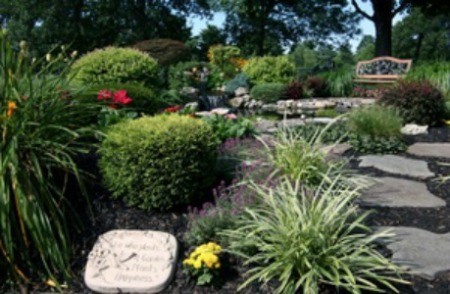
A big landscaping project can be a budget buster, but with a little creative planning it doesn't have to be. Here are some tips for creating a beautiful landscape without breaking the bank.
Hire a landscape designer or landscape architect to develop the plan, then do the work yourself. Another idea is to do what you can yourself, and hire out the rest. This way you'll get the advantage of a professional design and save money by doing some or all the work yourself.
Hiring a professional planner isn't in your budget? No worries. Consult with friends, family, and local garden centers, or look in books and magazines and at your library for free plans and ideas. Drive around your community, or take a stroll around your neighborhood to get ideas. Pay close attention to yards and gardens with a grade and exposure similar to yours. Work at your own pace so you can spread out the cost of the work. Prioritize your tasks. You don't have to get the whole landscaping project done in a single day, week, month-or even a single season.
Look for inexpensive (or free) alternatives. A stone retaining wall may be expensive, but concrete blocks from a recently finished construction project work just as well. Pay close attention to sites where buildings are being torn down. These are sometimes great opportunities to get free materials for hardscaping, as well as free plants.
If there are no alternatives to an expensive part of your project, reevaluate how important it is to your overall plan. For example, if you skip the pond, maybe you could afford to buy the outdoor furniture you want.
Watch for sales. Nurseries and garden centers tend to offer specials around the summer holidays, especially Mother's Day, Memorial Day, and Labor Day. This is the perfect time to pick up bargain priced trees, plants, as well as other decorative landscaping materials. Garage sales and estate sales are other great places to look for decorative elements.
Throw a 'garden warming' party. In lieu of gifts, suggest that your guests bring you cuttings or starts from their own gardens. People love to share their flowers and plants, and this is a great way to give your outdoor space special meaning.
Plant trees to give your landscape instant structure and draw attention away from portions of your plan that remain unfinished. Shrubs fill in even faster than trees and can be purchased in smaller sizes to save money.
Start with smaller perennial plants, trees, and shrubs. They are usually much cheaper, so if you suffer a few losses, your budget will be able to absorb the replacement costs. Then use annuals to fill in the gaps until your new landscaping gets going. A couple of flats of colorful bedding petunias are usually enough for full-season color.

About The Author: Ellen Brown is an environmental writer and photographer and the owner of Sustainable Media, an environmental media company that specializes in helping businesses and organizations promote eco-friendly products and services. Contact her on the web at http://www.sustainable-media.com
Add your voice! Click below to comment. ThriftyFun is powered by your wisdom!
I would only add one thing: we don't know how the financial world will look for the remainder of our life.
Plant any yard with at least 4 dwarf fruit trees and one standard fruit tree (think 5 spots on dice). The dwarf trees will live 10-30 years, depending on a lot of things.
Plant berry's of all kinds in great number.
Let those things be your health plan for your old age.
Let them be a joy for you great-grandchildren. We do not live for ourselves alone.
Thank you for that, I will see what the city has for projects slated soon involving demolition of existing structures, to get the plants out first. thanks!
Also, save receipts for plants that you purchase just in case they don't make it. Most stores have a year guarantee on nursery stock but if you save the receipt and the plant instructions you can return it for a replacement or refund. I keep them in a pocket organizer.
Add your voice! Click below to comment. ThriftyFun is powered by your wisdom!